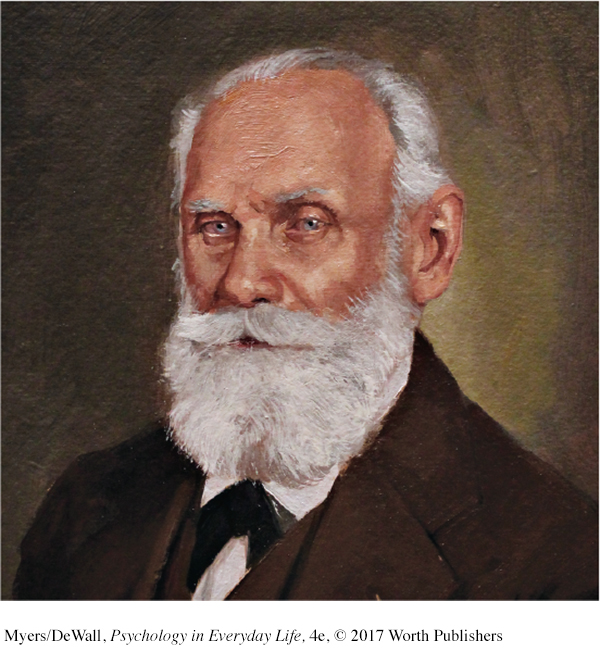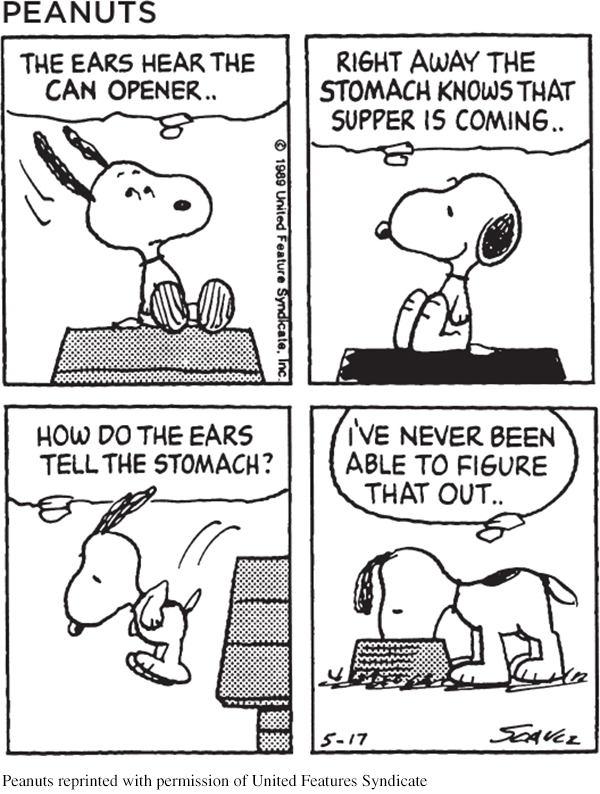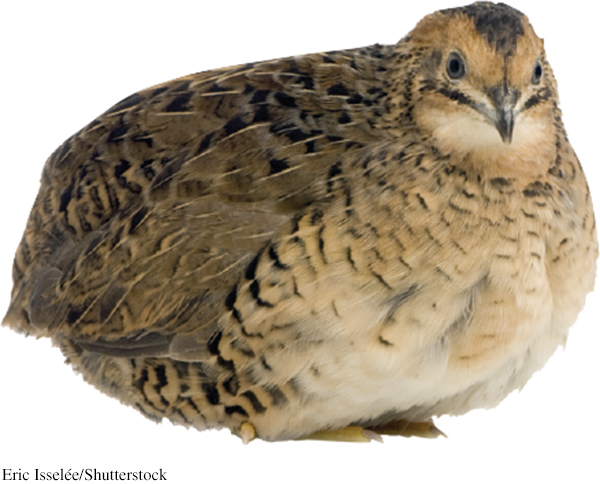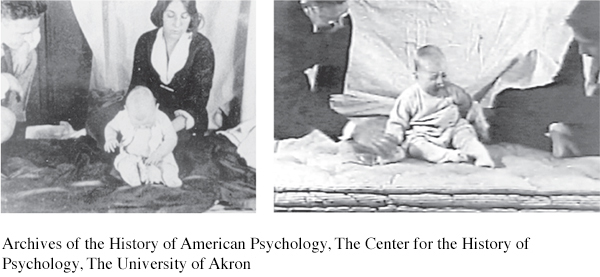6.2 Classical Conditioning
classical conditioning a type of learning in which we learn to link two or more stimuli and anticipate events.
For many people, the name Ivan Pavlov (1849–
Pavlov’s Experiments
LOQ 6-

neutral stimulus (NS) in classical conditioning, a stimulus that evokes no response before conditioning.
For his studies of digestion, Pavlov (who held a medical degree) earned Russia’s first Nobel Prize. But his novel experiments on learning, which consumed the last three decades of his life, earned Pavlov his place in history.
Pavlov’s new direction came when his creative mind focused on what seemed to others an unimportant detail. Without fail, putting food in a dog’s mouth caused the animal to drool—
Pavlov and his assistants tried to imagine what the dog was thinking and feeling as it drooled in anticipation of the food. This only led them into useless debates. So, to make their studies more objective, they experimented. To rule out other possible influences, they isolated the dog in a small room, placed it in a harness, and attached a device to measure its saliva. Then, from the next room, they presented food. First, they slid in a food bowl. Later, they blew meat powder into the dog’s mouth at a precise moment. Finally, they paired various neutral stimuli (NS)—events the dog could see or hear but didn’t associate with food—

The answers proved to be Yes and Yes. Just before placing food in the dog’s mouth to produce salivation, Pavlov sounded a tone. After several pairings of tone and food, the dog got the message. Anticipating the meat powder, it began salivating to the tone alone. In later experiments, a buzzer, a light, a touch on the leg, even the sight of a circle set off the drooling.
unconditioned response (UR) in classical conditioning, an unlearned, naturally occurring response (such as salivation) to an unconditioned stimulus (US) (such as food in the mouth).
unconditioned stimulus (US) in classical conditioning, a stimulus that unconditionally—
A dog doesn’t learn to salivate in response to food in its mouth. Rather, food in the mouth automatically, unconditionally, triggers this response. Thus, Pavlov called the drooling an unconditioned response (UR). And he called the food an unconditioned stimulus (US).
conditioned response (CR) in classical conditioning, a learned response to a previously neutral (but now conditioned) stimulus (CS).
conditioned stimulus (CS) in classical conditioning, an originally irrelevant stimulus that, after association with an unconditioned stimulus (US), comes to trigger a conditioned response (CR).
Salivating in response to a tone, however, is learned. Because it is conditional upon the dog’s linking the tone with the food (FIGURE 6.3), we call this response the conditioned response (CR). The stimulus that used to be neutral (in this case, a previously meaningless tone that now triggers drooling) is the conditioned stimulus (CS). Remembering the difference between these two kinds of stimuli and responses is easy: Conditioned = learned; unconditioned = unlearned.

Remember:
NS = Neutral Stimulus
US = Unconditioned Stimulus
UR = Unconditioned Response
CS = Conditioned Stimulus
CR = Conditioned Response
If Pavlov’s demonstration of associative learning was so simple, what did he do for the next three decades? What discoveries did his research factory publish in his 532 papers on salivary conditioning (Windholz, 1997)? He and his associates explored five major conditioning processes: acquisition, extinction, spontaneous recovery, generalization, and discrimination.
Retrieve + Remember
Question 6.2
•An experimenter sounds a tone just before delivering an air puff that causes your eye to blink. After several repetitions, you blink to the tone alone. What is the NS? The US? The UR? The CS? The CR?
ANSWERS:
NS = tone before conditioning
US = air puff
UR = blink to air puff
CS = tone after conditioning
CR = blink to tone
Acquisition
LOQ 6-
acquisition in classical conditioning, the initial stage, when we link a neutral stimulus and an unconditioned stimulus so that the neutral stimulus begins triggering the conditioned response. (In operant conditioning, the strengthening of a reinforced response.)
Acquisition is the first stage in classical conditioning. This is the point when Pavlov’s dogs learned the link between the NS (the tone, the light, the touch) and the US (the food). To understand this stage, Pavlov and his associates wondered: How much time should pass between presenting the neutral stimulus and the food? In most cases, not much—

What do you suppose would happen if the food (US) appeared before the tone (NS) rather than after? Would conditioning occur? Not likely. With only a few exceptions, conditioning doesn’t happen when the NS follows the US. Remember, classical conditioning is biologically adaptive because it helps humans and other animals prepare for good or bad events. To Pavlov’s dogs, the originally neutral tone became a CS after signaling an important biological event—
More recent research on male Japanese quail shows how a CS can signal another important biological event (Domjan, 1992, 1994, 2005). Just before presenting a sexually approachable female quail, the researchers turned on a red light. Over time, as the red light continued to announce the female’s arrival, the light caused the male quail to become excited. They developed a preference for their cage’s red-
Can objects, sights, and smells associated with sexual pleasure become conditioned stimuli for human sexual arousal, too? Indeed they can (Byrne, 1982; Hoffman, 2012). Onion breath does not usually produce sexual arousal (FIGURE 6.4). But when repeatedly paired with a passionate kiss, it can become a CS and do just that. The larger lesson: Conditioning helps an animal survive and reproduce—

Retrieve + Remember
Question 6.3
•In horror movies, sexually arousing images of women are sometimes paired with violence against women. Based on classical conditioning principles, what might be an effect of this pairing?
ANSWER: If viewing an attractive nude or seminude woman (a US) elicits sexual arousal in some viewers (a UR), then pairing the US with a new NS (violence) could turn the violence into a conditioned stimulus (CS) that also becomes sexually arousing, a conditioned response (CR).
Extinction and Spontaneous Recovery
extinction in classical conditioning, the weakening of a conditioned response when an unconditioned stimulus does not follow a conditioned stimulus. (In operant conditioning, the weakening of a response when it is no longer reinforced.)
spontaneous recovery the reappearance, after a pause, of an extinguished conditioned response.
What would happen, Pavlov wondered, if after conditioning, the CS occurred repeatedly without the US? If the tone sounded again and again, but no food appeared, would the tone still trigger drooling? The answer was mixed. The dogs salivated less and less, a reaction known as extinction—a drop-

Retrieve + Remember
Question 6.4
•The first step of classical conditioning, when an NS becomes a CS, is called _____. When a US no longer follows the CS, and the CR becomes weakened, this is called _____.
ANSWERS: acquisition; extinction
Generalization
generalization in classical conditioning, the tendency, after conditioning, to respond similarly to stimuli that resemble the conditioned stimulus. (In operant conditioning, generalization occurs when our responses to similar stimuli are also reinforced.)
Pavlov and his students noticed that a dog conditioned to the sound of one tone also responded somewhat to the sound of a new and different tone. Likewise, a dog conditioned to salivate when rubbed would also drool a bit when scratched or when touched on a different body part (Windholz, 1989). This tendency to respond similarly to stimuli that resemble the CS is called generalization.
Generalization can be adaptive, as when toddlers who learn to fear moving cars also become afraid of moving trucks and motorcycles. And generalized fears can linger. One Argentine writer who had been tortured recalled flinching with fear years later at the sight of black shoes—
Discrimination
discrimination in classical conditioning, the learned ability to distinguish between a conditioned stimulus and other irrelevant stimuli. (In operant conditioning, the ability to distinguish responses that are reinforced from those that are not.)
Pavlov’s dogs also learned to respond to the sound of a particular tone and not to other tones. This learned ability to distinguish between a conditioned stimulus (which predicts the US) and other irrelevant stimuli is called discrimination. Being able to recognize differences is adaptive. Slightly different stimuli can be followed by vastly different results. Facing a guard dog, your heart may race; facing a guide dog, it probably will not.
Retrieve + Remember
Question 6.5

•What conditioning principle is affecting the snail’s affections?
ANSWER: generalization
Pavlov’s Legacy
LOQ 6-
What remains today of Pavlov’s ideas? A great deal. Most psychologists now agree that classical conditioning is a basic form of learning. Judged with today’s knowledge of the biological and cognitive influences on conditioning, Pavlov’s ideas were incomplete. But if we see further than Pavlov did, it is because we stand on his shoulders.
Why does Pavlov’s work remain so important? If he had merely taught us that old dogs can learn new tricks, his experiments would long ago have been forgotten. Why should we care that dogs can be conditioned to drool at the sound of a tone? The importance lies first in this finding: Many other responses to many other stimuli can be classically conditioned in many other creatures—in fact, in every species tested, from earthworms to fish to dogs to monkeys to people (Schwartz, 1984). Thus, classical conditioning is one way that virtually all animals learn to adapt to their environment.
Second, Pavlov showed us how a process such as learning can be studied objectively. He was proud that his methods were not based on guesswork about a dog’s mind. The salivary response is a behavior we can measure in cubic centimeters of saliva. Pavlov’s success therefore suggested a scientific model for how the young field of psychology might proceed. That model was to isolate the basic building blocks of complex behaviors and study them with objective laboratory procedures.
Retrieve + Remember
Question 6.6
•If the aroma of cake baking makes your mouth water, what is the US? The CS? The CR?
ANSWERS: The cake is the US. The associated aroma is the CS. Salivation to the aroma is the CR.
 To review Pavlov’s classic work and to play the role of experimenter in classical conditioning research, visit LaunchPad’s PsychSim 6: Classical Conditioning. See also a 3-
To review Pavlov’s classic work and to play the role of experimenter in classical conditioning research, visit LaunchPad’s PsychSim 6: Classical Conditioning. See also a 3-
Classical Conditioning in Everyday Life
Other chapters in this text—
Drugs given as cancer treatments can trigger nausea and vomiting. Patients may then develop classically conditioned nausea (and sometimes anxiety) to the sights, sounds, and smells associated with the clinic (Hall, 1997). Merely entering the clinic’s waiting room or seeing the nurses can provoke these feelings (Burish & Carey, 1986).
Former drug users often feel a craving when they are again in the drug-
using context. They associate particular people or places with previous highs. Thus, drug counselors advise their clients to steer clear of people and settings that may trigger these cravings (Siegel, 2005).
Does Pavlov’s work help us understand our own emotions? John B. Watson thought so. He believed that human emotions and behaviors, though biologically influenced, are mainly a bundle of conditioned responses (1913). Working with an 11-
For years, people wondered what became of Little Albert. Detective work by Russell Powell and his colleagues (2014) found that the child of one of the campus hospital’s wet nurses matched Little Albert’s description. The child, William Albert Barger, went by Albert B.—precisely the name used by Watson and Rayner. This Albert died in 2007. He was an easygoing person, though, perhaps coincidentally, he had an aversion to dogs. Albert died without ever knowing of his role in psychology’s history.
People also wondered what became of Watson. After losing his Johns Hopkins professorship over an affair with Rayner (whom he later married), he joined an advertising agency as the company’s resident psychologist. There, he used his knowledge of associative learning in many successful advertising campaigns. One of them, for Maxwell House, helped make the “coffee break” an American custom (Hunt, 1993).
The treatment of Little Albert would be unethical by today’s standards. Also, some psychologists had difficulty repeating Watson and Rayner’s findings with other children. Nevertheless, Little Albert’s learned fears led many psychologists to wonder whether each of us might be a walking storehouse of conditioned emotions. If so, might extinction procedures or new conditioning help us change our unwanted responses to emotion-
 See LaunchPad’s Video: Research Ethics for a helpful tutorial animation.
See LaunchPad’s Video: Research Ethics for a helpful tutorial animation.
Comedian-
Retrieve + Remember

Question 6.7
•In Watson and Rayner’s experiments, “Little Albert” learned to fear a white rat after repeatedly experiencing a loud noise as the rat was presented. In these experiments, what was the US? The UR? The NS? The CS? The CR?
ANSWERS: The US was the loud noise; the UR was the fear response to the noise; the NS was the rat before it was paired with the noise; the CS was the rat after pairing; the CR was fear of the rat.